Protecting & Restoring Long Island's Peconic Bays
Citizen science programs, events and educational materials for all ages.
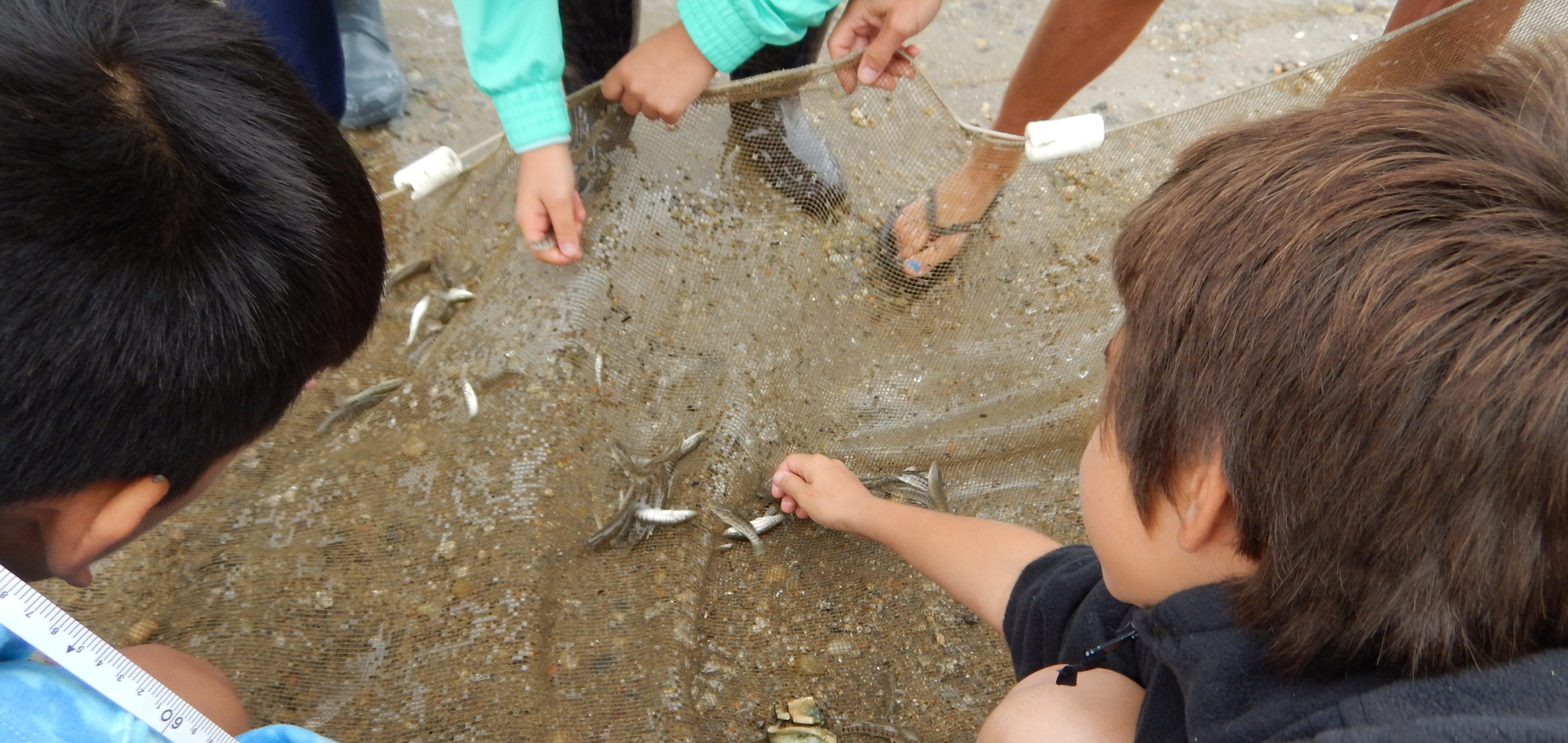
Our community and visitors play an active role in the PEP by supporting, promoting and participating in efforts to protect this not so hidden gem on the East End. To view our upcoming events, visit our calendar of events. Never miss a volunteer opportunity by joining our mailing list and by following us on Facebook.
Join the Peconic Estuary Partnership’s Citizens’ Advisory Committee, an important part of the PEP Management Conference. Get updates on the projects that are being implemented in our bays and learn how you can be involved to improve water quality, wildlife habitat, and coastal resiliency. As a member, you’ll help us spread public awareness of the estuary while advising the PEP about important goals and concerns of the citizens of Long Island’s East End. It is a unified effort to protect and restore the Peconic Estuary, and we want you to be a part of the conversation! Visit the CAC page for more information.
The Peconic Estuary Partnership provides many opportunities for you to get involved by attending an educational event or volunteering through our ongoing programs.
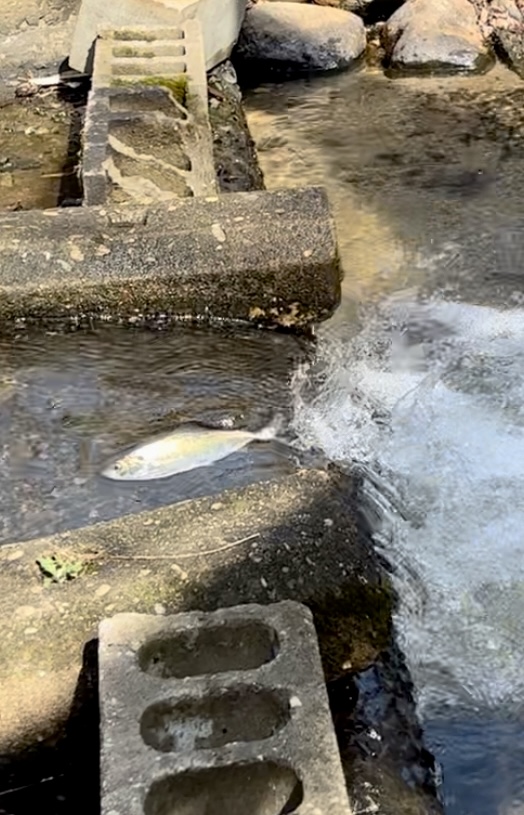
Every spring, Alewife – a type of River Herring, travel from the ocean to coastal waters and eventually
make their way into freshwater rivers and streams to spawn. This species plays an important role in the estuary food web as it serves as prey for many species including osprey and predatory fish like striped-bass and bluefish. However, barriers – such as dams and road culverts – can block Alewife from reaching their ideal spawning habitat. Dams, habitat loss and declining water quality have decimated their numbers. Remnant populations exist, but there is still little known about their overall status across Long Island. Documenting existing spawning runs is an important step in the restoration effort.
The Peconic Estuary Partnership is working with its partners to restore access for Alewife to their critical freshwater habitat by providing passage through or around these barriers. In 2010 a fishway was built at the Grangebel Park Dam on the Peconic River, restoring access to 25 acres of habitat for Alewife and other diadromous fish. Since the completion of this fishway, the PEP has been monitoring Alewife on the Peconic River, through visual fish counts and biological sampling. A video camera is installed annually in the river at Grangebel Park to get a better estimate of the number of Alewife using this fishway to travel up the Peconic River to spawn.
Fish passage projects like these are made possible when we have an understanding of where Alewife spawning runs exist around the Estuary. This is where community scientists like you can help us gain this understanding by watching for returning Alewives between the months of March-May. You can attend a volunteer training workshop to learn how to identify and record sightings to help monitor this important species. You will be a part of a large network of volunteers helping us to continue restoration and conservation efforts. Volunteer training workshops are held at the end of February and in March. These workshops are designed to help you identify what to look for and how to record your sightings in Seatuck Environmental Association’s Long Island Volunteer River Herring online survey. Workshops are advertised on our Events calendar and recordings of these workshops will be posted here.
Volunteer Training Resources:
Watch PEP’s East End Regional Training 2021 Video
2021 East End River Herring & Eel Monitoring Locations
2021 Long Island River Herring & Eel Monitoring Protocol
Seatuck’s Long Island Volunteer River Herring & Eel Online Survey – Where to record your sightings
River Revival Map – Where River Herring is spotted around Long Island

Each spring, Atlantic Horseshoe Crabs, Limulus polyphemus, come to shore during the new and full moon high tide in the evening to spawn. The Peconic Estuary Partnership is part of the Horseshoe Crab Monitoring Network hosting a monitoring site at Squires Pond at the end of East Landing Road in Hampton Bays. Volunteers are encouraged to come learn about horseshoe crab biology and get a hands on experience helping scientists learn more about the population by measuring size and tagging used to assess the status of horseshoe crabs in NY State, and will help determine the management and conservation of this important species.
Monitoring runs from May through June. You can join one event, attend multiple or become a site coordinator.
To learn more, visit the New York Horseshoe Crab Monitoring Network website.
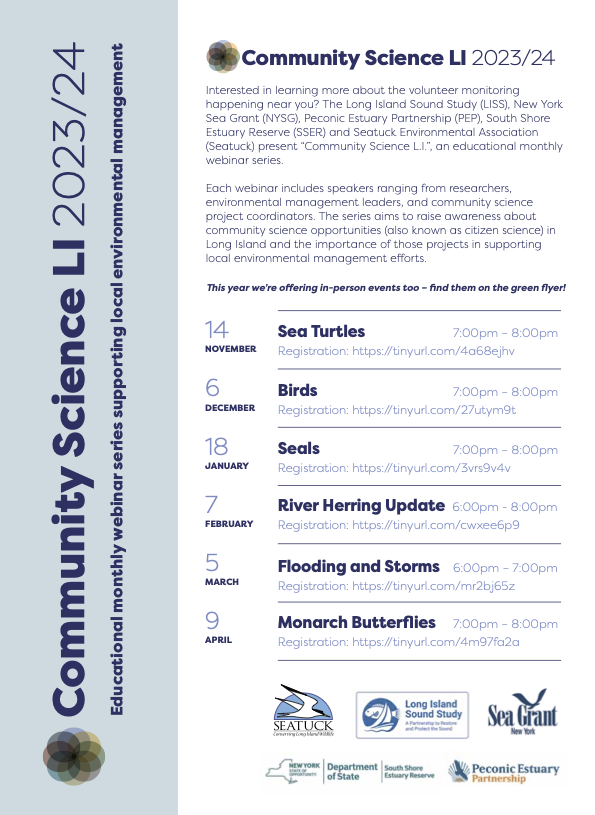

Community Science LI (CSLI) is an annual educational webinar series that highlights various community science opportunities around Long Island, and the importance of those projects in supporting local wildlife conservation efforts. Webinars coincide with the survey season for each monitoring program.
The series will span from November 2023 to April 2024, covering topics such as Sea Turtles, Birds, Seals, River Herring, Flooding & Storms, and Monarch Butterflies. In addition to these exciting webinars, CSLI will be hosting 7 in-person events related to each topic!
CSLI is hosted by Seatuck together with PEP, Long Island Sound Study, NY Sea Grant, and the South Shore Estuary Reserve.
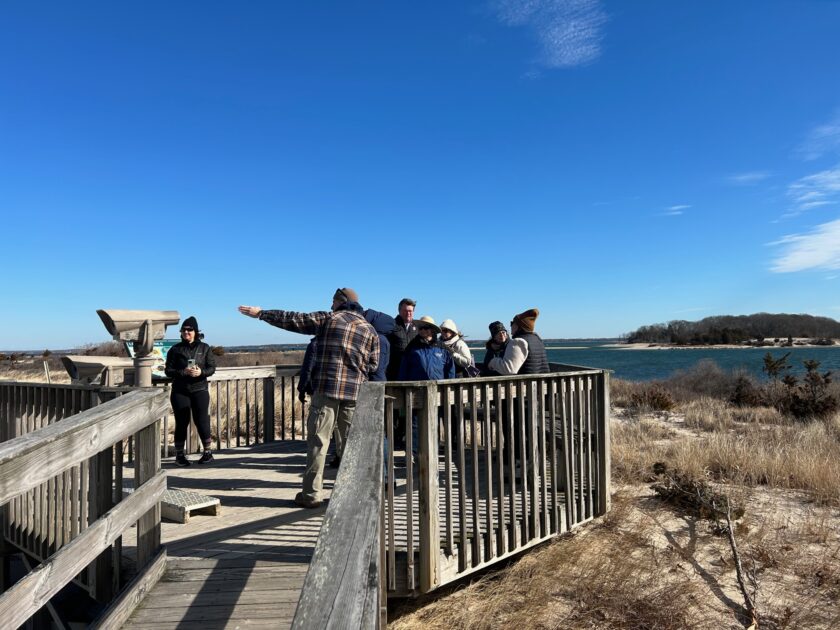
Join Peconic Baykeeper and Peconic Estuary Partnership in the second year of our Winter Watershed Walk Series! This year’s series features four new and different locations around the Peconic Estuary.
We are hitting the trails again this winter to explore some of the beautiful locations around the Peconic Estuary. This is a great chance to learn more about the coastal habitats in the watershed. Walks are open to all ages, please register ahead of time so we may contact you in the event of a cancellation or rescheduling. Please dress for your comfort, warm layers, hats and gloves are encouraged. We will plan to meet at the trail head and begin walks by 10:10am if you are running late or can no longer attend a walk you have signed up for please let us know. We will do our best to wait for all confirmed registrants. Register Here!
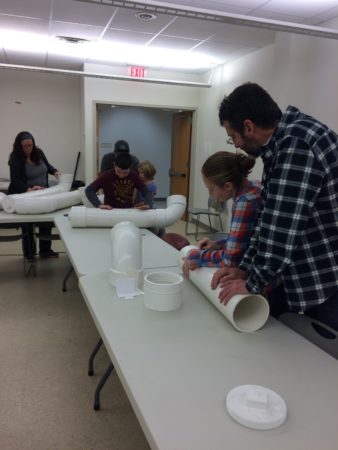
Excess fishing line is one of the most common a deadliest forms of marine trash to wildlife. While the transparency of fishing line is ideal for catching unsuspecting fish, that same feature makes it near impossible to marine life to avoid it when discarded into our waterways. Animals can become entangled and even ingest the fishing line causing harm and frequently death.
During a workshop in December 2016, volunteers assembled 16 fishing line receptacles to be placed around the Peconic Estuary to help combat plastic marine debris. Monofilament (single stranded fishing line) can be discarded into fishing line receptacles to be collected by PEP staff and volunteers, quantified, and sent to the Berkley Fishing Line Company to be recycled. In the future, PEP will aim to install additional fishing line receptacles to collect braided fishing line, which due to its composition of multiple plastics, is not easily recycled. Collecting braided fishing line is still important and disposing of the material properly will help keep it out of our waterways.
Check out PEP’s fishing line receptacle map to find out where you can recycle your fishing line both from PEP receptacles and partner locations. Know of a receptacle not on the map? Let PEP know so we can include it!
PEP has created fun and educational worksheets, activities and pamphlets for educators to use for their students and parents to use for their kids! Visit our Resources for Educators page to view all of PEP’s English and Spanish material.
Click here for a full list of PEP’s informational resources on the Peconic Estuary
Search here for educational Digital Brochures
Best Management Practices to be a “Peconic Friendly Citizen”
Fertilizer reduction and elimination
Proper disposal of hazardous waste
Stormwater pollution reduction
Responsible boating
Sign up for News, Events and Information straight to your inbox.
